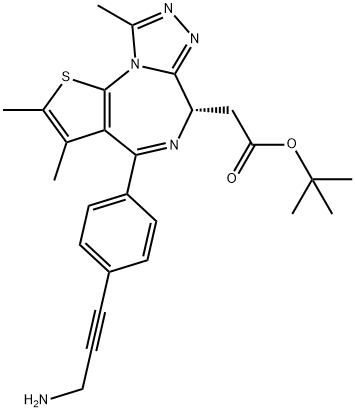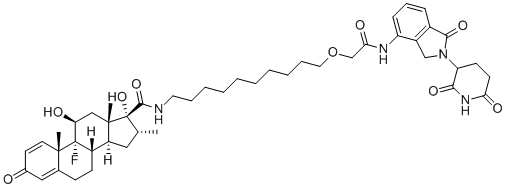| DC74473 |
Thalidomide-O-PEG4-Acid |
Thalidomide-O-PEG4-Acid is a chemical linker for PROTAC design. |

|
| DC74474 |
(R)-SL18 |
(R)-SL18 is a first-in-class, selective Annexin A3 (ANXA3) degrader, induces degradation of ANXA3 in MDA-MB-231 cells with DC50 value of 3.17 uM. |

|
| DC74475 |
ARD-1676 |
ARD-1676 (ARD1676) is a highly potent and orally efficacious PROTAC degrader of the androgen receptor (AR) with DC50 values of 0.1 and 1.1 nM in AR+ VCaP and LNCaP cell lines, respectively. |

|
| DC74476 |
BI 1810284 |
BI 1810284 (ACBI2, BI 01810284) is a potent, selective and orally bioavailable VHL-recruiting PROTAC degrader of SMARCA2 (DC50=1 nM in RKO cells), 30-fold selectivity over SMARCA4. |

|
| DC74477 |
BJG-05-039 |
BJG-05-039 is a PAK1-selective degrader consisting of NVS-PAK1-1 conjugated to lenalidomide, a recruiter of the E3 ubiquitin ligase substrate adaptor Cereblon. |

|
| DC74478 |
BSJ-04-146 |
BSJ-04-146 is a potent, selective FAK PROTAC (IC50=26 nM), induces potent and durable FAK degradation in pancreatic and breast cancer cell lines at 10 nM. |

|
| DC74479 |
BSJ-05-037
Featured
|
BSJ-05-037 is a potent and selective heterobifunctional degrader of ITK with DC50 of 17.6-41.8 nM in TCL lines DERL-2 and Hut78. |

|
| DC74480 |
BTX-6654 |
BTX-6654 is a potent, selective SOS1 cereblon-based bifunctional PROTAC degrader, reduces downstream signaling markers, pERK and pS6, and displayed antiproliferative activity in cells harboring various KRAS mutations. |

|
| DC74481 |
BWA-522 |
BWA-522 is a potent, orally bioavailable PROTAC degrader of the androgen receptor N-terminal domain (AR-NTD), induces AR-FL or AR-V7 protein degradationwith DC50 of 0.73 μM (AR-FL) and 0.67 μM (AR-V7) in VCaP cells. |

|
| DC74483 |
Chk1 PROTAC-2 |
Chk1 PROTAC-2 is a potent Chk1 degrader with DC50 of 1.33 µM in A375 cells. |

|
| DC74484 |
CRBN(BRAF)-24 |
CRBN(BRAF)-24 is a potent small molecule degrader against oncogenic BRAF V600E protein, potently degrades BRAFV600E in a ubiquitin–proteasome system (UPS)-dependent manner and inhibits the proliferation of BRAFV600E-driven cancer cells. |

|
| DC74485 |
CRBN(FLT3)-8 |
CRBN(FLT3)-8 a highly potent FLT3 degrader by introducing gilteritinib into targeted protein degradation technology, potently degrades FLT3-ITD via UPS and inhibits the proliferation of FLT3-ITD mutant AML cells more effectively than gilteritinib. |

|
| DC74486 |
DAS-5-oCRBN |
DAS-5-oCRBN is a potent and selective PROTAC for c-Src kinase with DC50 value of 3 nM, without effect on Bcr-Abl. |

|
| DC74487 |
DAS-CHO-5-oCRBN |
DAS-CHO-5-oCRBN is a potent and selective PROTAC for c-Src kinase with DC50 value of 62 nM in CAL148 cells. |

|
| DC74488 |
DB0614 |
DB0614 is a CRBN-based PROTAC, induces the degradation of NEK9, FAK, CDK4, CDK6, and WEE1 in cells. |

|
| DC74489 |
DBt-10 |
DBt-10 is a potent BTK-specific DCAF1 PROTAC with TR-FRET IC50 of 136 nM, potently degrades BTK with DC50 of 137 nM in TMD8 BTK-GFP/mCherry cell-based assays. |

|
| DC74490 |
dEALK1 |
dEALK1 is a small-molecule degrader of EML4-ALK fusion proteins with binding constant (Kd) value of 44 nM for kinase domain of recombinant ALK, overcomes resistance to ALK inhibitor ceritinib. |

|
| DC74491 |
DeFer-2 |
DeFer-2 is an oleic acid (OA)-based ferritin-targeting PROTAC binding Kd of 17.1 uM, degrades ferritin and rapidly elevates the free iron content, induces pyroptosis. |

|
| DC74492 |
Degradomer D-1 |
Degradomer D-1 is a selective proteasomal degrader of IRAK3 with Kd of 100 nM, DC50 of 94 nM, displays no binding affinity against IRAK4 (Ki >10 uM). |

|
| DC74493 |
DU-14 |
DU-14 is a highly potent and selective small molecule degrader for both PTP1B and TC-PTP with DC50 values of 4.3 and 4.8 nM, respectively, in HEK293 cells after 16 hours treatment. |

|
| DC74494 |
GNE-0011
Featured
|
GNE-0011 is a monovalent, JQ1-based BRD4 degrader that is not linked to an E3 ligase binder, triggers proteasomal and ubiquitin-dependent selective degradation of BRD4 over BRD2 and BRD3. |

|
| DC74495 |
HDAC3 PROTAC P7 |
HDAC3 PROTAC P7 is a potent and selective HDAC3-directed PROTAC with IC50 of 40 nM (HDAC3 deacetylase activity), effectively induces HDAC3 degradation with DC50 of 0.6 nM in THP-1 cells (Emax=90%). |

|
| DC74496 |
HJM-561 |
HJM-561 is a potent, selective and orally bioavailable EGFR PROTAC degrader, selectively degrades the EGFR C797S-containing triple mutants Del19/T790M/C797S and L858R/T790M/C797S with DC50 values of 9.2 nM and 5.8 nM, respectively. |

|
| DC74497 |
HPP-9 |
HPP-9 is a potent BET bromodomain degrader that acts through a PROTAC mechanism, HPP-9 is a long-acting Hedgehog pathway inhibitor. |

|
| DC74498 |
INY-06-061 |
INY-06-061 is a potent and selective heterobifunctional degrader of ERK5 with binding Kd of 12 nM and DC50 of 21 nM in MOLT4 cells (5h treatment). |

|
| DC74499 |
JCS-1 |
JCS-1 is a RG3039-based degarder (PROTAC) of the RNA decapping scavenger protein DcpS exhibiting effective degradation of DcpS at nanomolar concentrations, non-covalently binds DcpS and recruits the E3 ligase VHL, induces potent, rapid, and sustained DcpS |

|
| DC74500 |
JET-209 |
JET-209 (JET209) is a potent, selective PROTAC degrader of CBP/p300 based on GNE-207 with DC50 of 0.05 nM for CBP and 0.2 nM for p300, Dmax >95% for both proteins in the RS4;11 leukemia cell line. |

|
| DC74501 |
JH-XII-03-02 |
JH-XII-03-02 is a highly potent, selective PROTAC degrader of LRRK2 with IC50 of 1 nM against both wt LRRK2 and LRRK2 G2019S. |

|
| DC74502 |
JWZ-1-80 |
JWZ-1-80 is a potent and selective PROTAC degrader of PI5P4Kγ with Kd of 510 nM, 1 uM induces 75% reduction of PI5P4Kγ in Molt4 cells. |

|
| DC74503 |
KH-103
Featured
|
KH-103 is a highly potent, catalytically-driven glucocorticoid receptor (GR) PTORAC degrader, demonstrate excellent performance in passively preventing ligand-induced gene expression activation in the absence of partial agonistic transcriptional triggerin. |

|
 DC Chemicals' products qualify for U.S. tariff exemptions. We guarantee no price increases due to customs duties and maintain stable supply, continuing to deliver reliable research solutions to our American clients.
DC Chemicals' products qualify for U.S. tariff exemptions. We guarantee no price increases due to customs duties and maintain stable supply, continuing to deliver reliable research solutions to our American clients.





























